The forex market is huge, with $850 million traded every second. It’s the largest and most liquid financial market globally. It runs 24/7, five days a week, with over $7.5 trillion traded daily. What is forex trading? It’s about buying one currency and selling another to make money from value changes.
Forex trading is a global market where people, businesses, and institutions trade currencies to make profits. Major currency pairs like EUR/USD, USD/JPY, and GBP/USD make up about 80% of trading. Knowing the basics is key to understanding this complex market.
The market is shaped by economic indicators. About 75% of all forex deals involve the U.S. dollar.
The Basics of Forex Trading
The forex market is a global place where people trade currencies. It’s huge, with over $7.5 trillion traded every day. Investors bet on how currency prices will change, using pairs like the Euro (EUR) and the U.S. dollar (USD).
Trading currencies is risky, as you can lose more than you started with. But, the market’s liquidity makes big trades easier. It’s open 24/7, 5 days a week, thanks to trading centers in London, New York, Sydney, and Tokyo.
Definition of Foreign Exchange
Foreign exchange, or forex, is when you swap one currency for another. This happens in the forex market, where many people and groups trade. It’s the biggest financial market globally, with lots of players like central banks and retail traders.
The Global Currency Market Explained
The global currency market is complex, with countries exchanging currencies. It’s driven by supply and demand, with rates always changing. Many things affect the market, like economic news, politics, and how people feel about the market.
Key Players in Forex Trading
Important players in forex trading include central banks, commercial banks, and retail traders. Central banks set money policies and control the money supply. Commercial banks add liquidity, while retail traders bet on currency prices. Other big players include hedge funds, investment banks, and big companies.
The History and Evolution of Currency Trading
Currency exchange started in the 6th century BC, during the Babylonian period. Gold coins were first made in the same century. This was a big change in how people exchanged money.
By the end of the 18th century, most countries used the gold standard. This made sure paper money was worth as much as gold.
The foreign exchange market has changed a lot over time. In 1973, countries moved to a free-floating currency system. This was a big change in forex trading strategies.
In the 1980s, electronic trading systems came out. Online brokers followed in the 1990s. These changes made trading easier and cheaper for everyone.
Now, the forex market is the biggest in the world. It trades around $6.6 trillion every day. Digital platforms let people trade directly, using forex trading strategies.
There’s a growing focus on ESG factors in trading. This shows the market is becoming more aware of sustainable practices.

Artificial intelligence (AI) and machine learning are making trading better. As the market grows, traders need to keep up with new strategies and trends.
How Forex Markets Function
The Forex market is open 24/7. Trading happens in different parts of the world. This means traders can trade at any time, as long as there’s a session open.
Forex brokers and trading platforms are key. They help traders make smart choices and trade well. With these tools, traders can access the market from anywhere, anytime.
Trading Sessions and Market Hours
The Forex market has four main sessions: Asian, European, American, and Pacific. Each has its own feel and market trends. Knowing these sessions and their hours is key for traders.
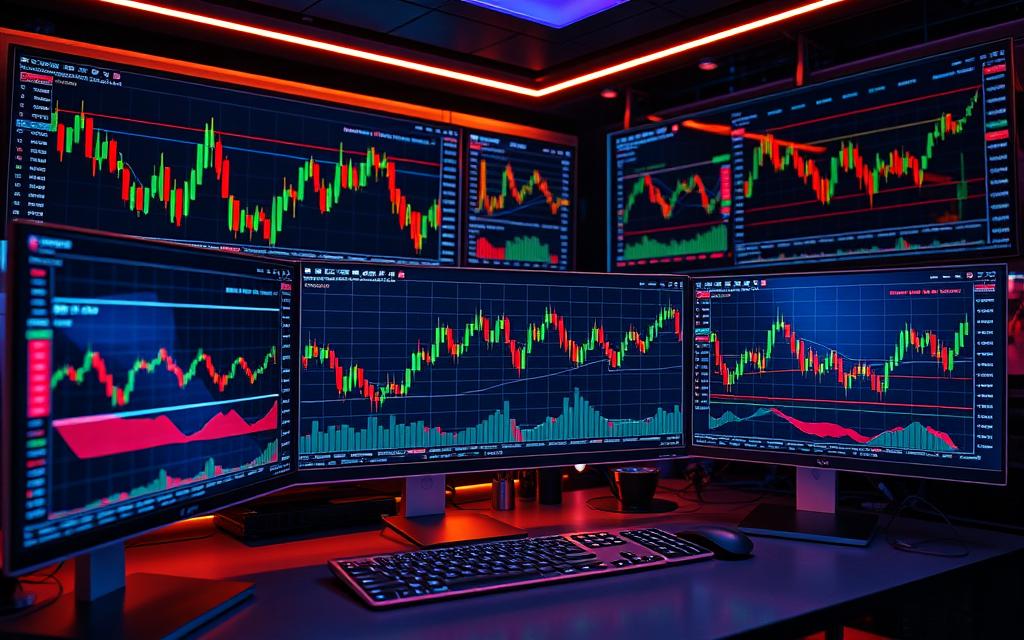
Currency Pairs and Their Categories
There are major, minor, and exotic currency pairs. Major pairs like EUR/USD are the most traded. Minor and exotic pairs are less traded and more volatile.
Brokers offer many currency pairs for traders. Traders can use platforms to access these pairs and trade efficiently.
What is Forex Trading and its Core Principles
Forex trading, or foreign exchange trading, is a global market for trading currencies. It has a huge trading volume, over $5 trillion daily. This is much bigger than the equities market’s $200 billion daily volume. What is forex trading involves understanding supply and demand, market sentiment, and technical analysis. These are key parts of forex analysis.
The forex market is open 24/7, five days a week. This means traders from everywhere can trade. To start, you need to know about currency pairs and types of forex analysis, like fundamental and technical.
Forex trading has important principles like leverage, margin, and risk management. In the U.S., leverage can be up to 1:50. This lets a trader with $1,000 control $50,000 in currency. But, it also means big risks. So, it’s crucial to use stop-loss orders and manage risks well.
To succeed in forex trading, you need to understand how currency prices move. Traders must keep up with economic indicators and interest rates. By using both technical and fundamental forex analysis, traders can better predict price changes.

Essential Components of Currency Trading
Currency trading, also known as forex trading, is about buying one currency and selling another. This is done to make money from value changes. Knowing the forex basics is key to doing well in this market. The forex market is huge, with over $1.165 trillion traded daily.
In the forex market, trading happens in lots. A micro lot is 1,000, a mini lot is 10,000, and a standard lot is 100,000. Using leverage lets traders handle bigger positions, but it also ups the risk of losing money.
Leverage and Margin
Leverage and margin are big in currency trading. Margin needs for forex trading usually range from 3% to 5% of the total value. Some pairs can start at just 2%.
Spreads and Commissions
Spreads and commissions are key in forex market trading. The spread is the price difference between buying and selling. Major pairs like USD, JPY, EUR, AUD, CAD, GBP, CHF, and NZD have smaller spreads than exotic pairs.

Order Types and Execution
Knowing about order types and how they work is crucial for forex basics. There are market orders, limit orders, and stop-loss orders. The forex market is open 24/7, five days a week, offering constant trading chances.
Major Currency Pairs in Forex Markets
In the world of currency trading, major currency pairs are key. They are the most traded and make up most of the foreign exchange market volume. The top four pairs are EUR/USD, USD/JPY, GBP/USD, and USD/CHF.
These pairs are major because they include the US dollar, the most traded currency. The EUR/USD pair leads, making up over 20% of all foreign exchange deals. The USD/JPY pair is second, followed by GBP/USD and USD/CHF.
Major pairs are known for their high liquidity, tight spreads, and low volatility. These traits attract traders, allowing for quick and smooth transactions. The high demand for these pairs results in smaller spreads compared to exotic pairs.
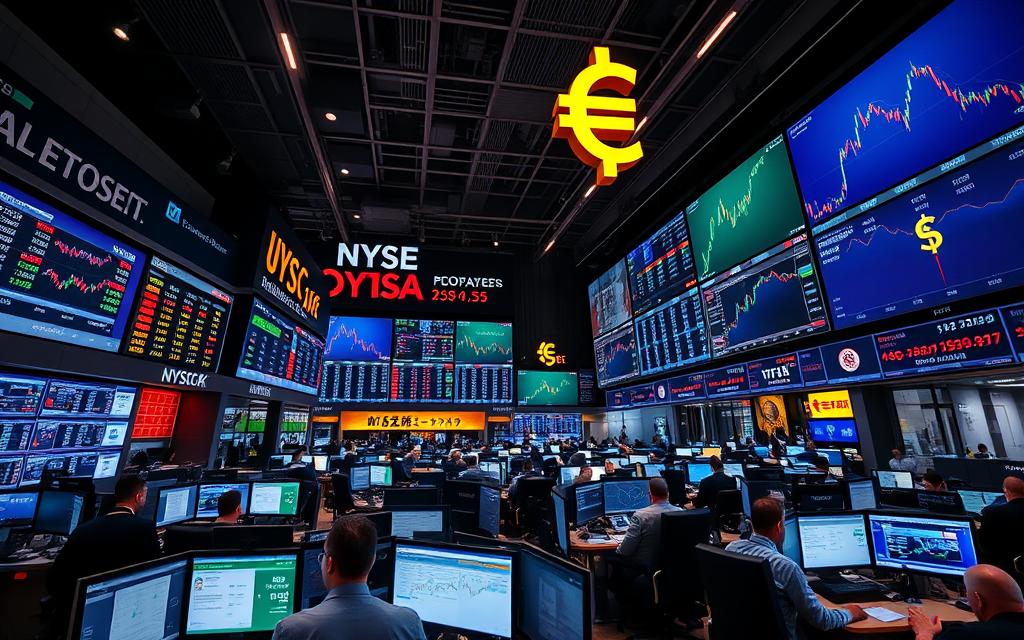
Understanding major currency pairs is vital for success in currency trading. Traders must keep up with market trends and economic indicators. This knowledge helps them make better decisions and increase profits in the foreign exchange market.
Forex Analysis Methods
Forex trading uses different methods to guess price changes and make smart choices. Two main ways are technical and fundamental analysis. Technical analysis looks at charts and patterns to guess future prices. Fundamental analysis looks at economic factors that affect currency prices.
Traders often mix technical and fundamental analysis for better decisions. Forex brokers give traders tools and resources for market analysis and trading. Some also use sentiment analysis to guess price changes.
When picking a forex analysis method, consider:
- Market trends and patterns
- Underlying economic factors, such as interest rates and inflation
- Market sentiment and investor behavior
Understanding these and using the right methods, traders can create effective forex trading strategies. They can also work with top forex brokers to reach their trading goals.
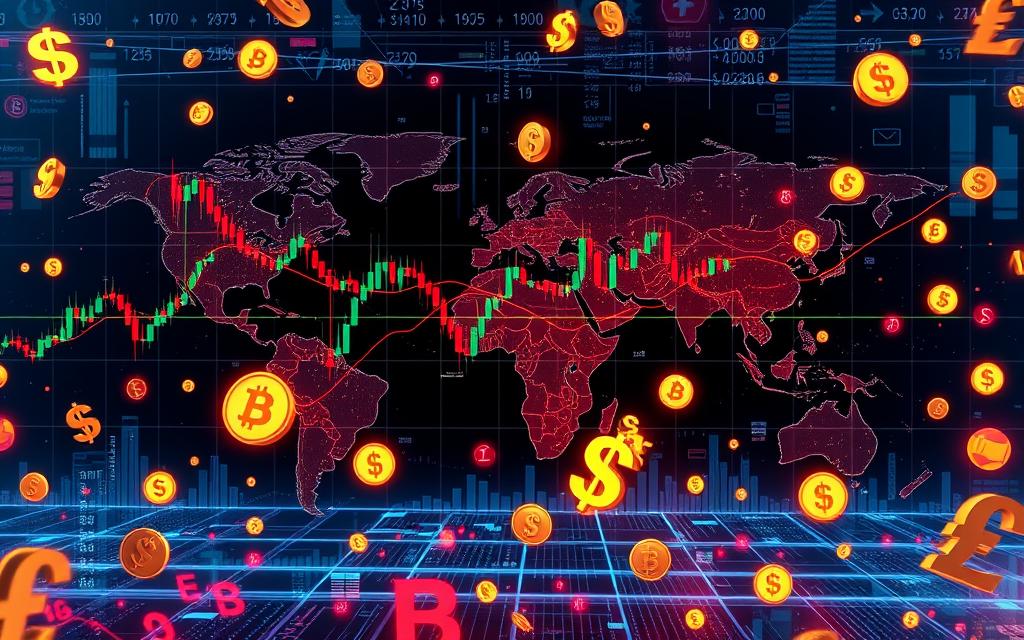
Getting Started with Forex Trading
To start trading in the forex market, you need to know the basics of forex trading platforms and forex analysis. First, open a trading account with a trusted broker. This is a simple process. Then, you can deposit money using different methods like debit card, bank transfer, or PayPal.
A good forex trading platform is key for success. These platforms have tools like real-time charts and technical analysis software. These tools help traders understand the currency markets better. Forex analysis is also vital for making smart trading decisions.
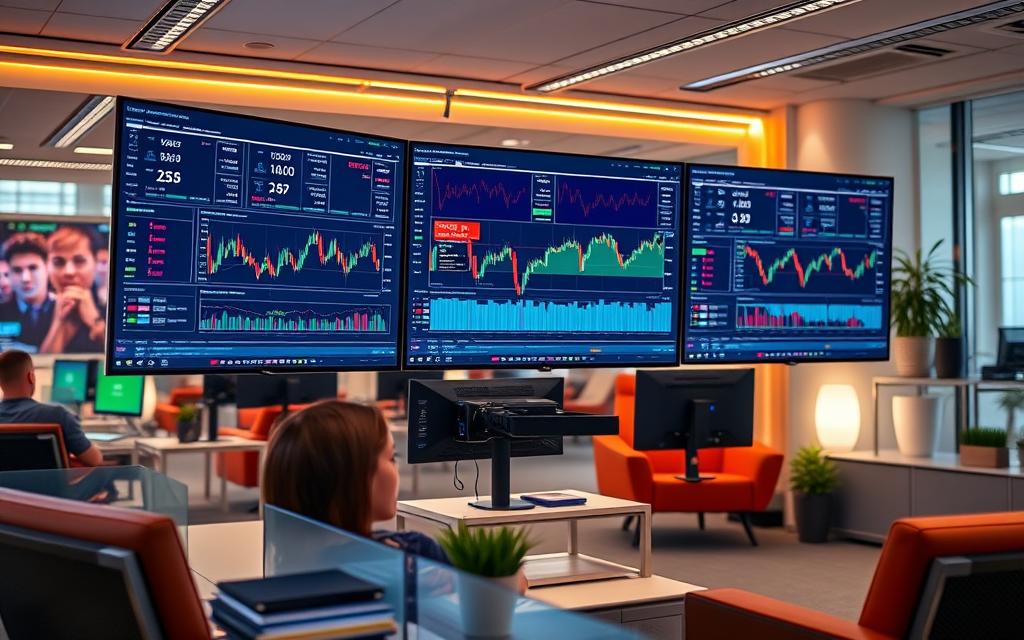
- Choose a reputable broker with good spreads
- Learn about the different trading accounts, like mini or standard
- Get to know your trading platform and its features
- Develop a trading strategy and risk management plan
By following these steps and staying updated on the forex market, traders can succeed. They can make the most of their forex trading platforms and forex analysis tools.
Choose the Right Forex Broker
When you’re into what is forex trading, picking a good forex broker is key. Start by looking at if the broker is regulated and safe. A top broker should be registered with a group like the Financial Conduct Authority (FCA). This means your money is protected.
Next, think about the trading platform the broker offers. It should be easy to use, dependable, and have cool tools for making smart trades. Forex basics like leverage, margin, and spreads are also important when picking a broker.
Key Factors to Consider
- Regulatory compliance and safety
- Trading platform features and reliability
- Account types and requirements, including initial deposit and leverage
- Customer support and education resources
By looking at these points, you can pick a forex broker that fits your needs. Many brokers also have demo accounts. These let you try out the platform without risking real money.
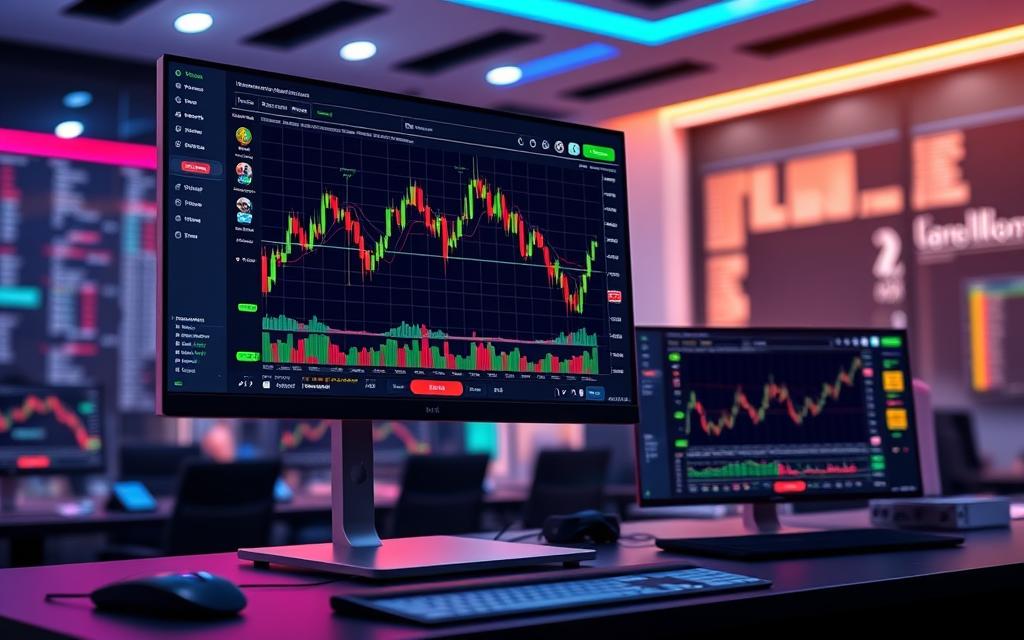
Choosing the right forex broker is a big deal for forex trading success. Do your homework and think about what matters most. This way, you’ll find a broker that’s reliable and helps you reach your trading goals.
Risk Management in Forex Trading
Effective risk management is key to success in the forex market, where trading volume hits about $7.5 trillion daily. Traders should limit their risk per trade to a small percentage, like 2% of their total capital. For example, with a $5,000 account, the max loss per trade should be $100.
In currency trading, leverage can reach 100:1. This lets traders control big positions with a small deposit. But, it also ups the risk of big losses. A one pip loss under 100:1 leverage can mean a loss of about $10. To cut down on this risk, traders use stop-loss orders, limit orders, and position sizing.
Some key risk management strategies include:
- Setting stop-loss orders to automatically close positions at a specified price
- Using limit orders to enter or exit trades at a specific price
- Position sizing to manage the amount of capital at risk

By using these strategies, traders can manage their risk well and boost their success in the forex market. It’s also vital to accept losses as part of trading. The forex market is driven by supply and demand. Traders must adapt to market changes and manage their risk well.
Common Trading Strategies for Beginners
For beginners in foreign exchange, the many forex trading strategies can be overwhelming. Yet, focusing on a few key strategies can boost success chances. Day trading, position trading, and swing trading are popular in the forex market.
Day trading means making one trade a day that’s closed before night. Swing trading holds positions for days to profit from price changes. Position trading keeps positions for weeks, months, or years. These strategies use technical, fundamental, and market sentiment analysis.
Beginners often use the pin bar, inside bar, and breakout strategies. The pin bar strategy can lead to about 370 pips profit on the GBPCAD daily chart. The inside bar strategy uses a “mother bar” for size comparison. Breakout strategies can lead to quick, large profits.
Beginners should start with one or two strategies to focus better. Trading for beginners should also build patience and discipline. Mastering these strategies and staying disciplined can help beginners succeed in foreign exchange.
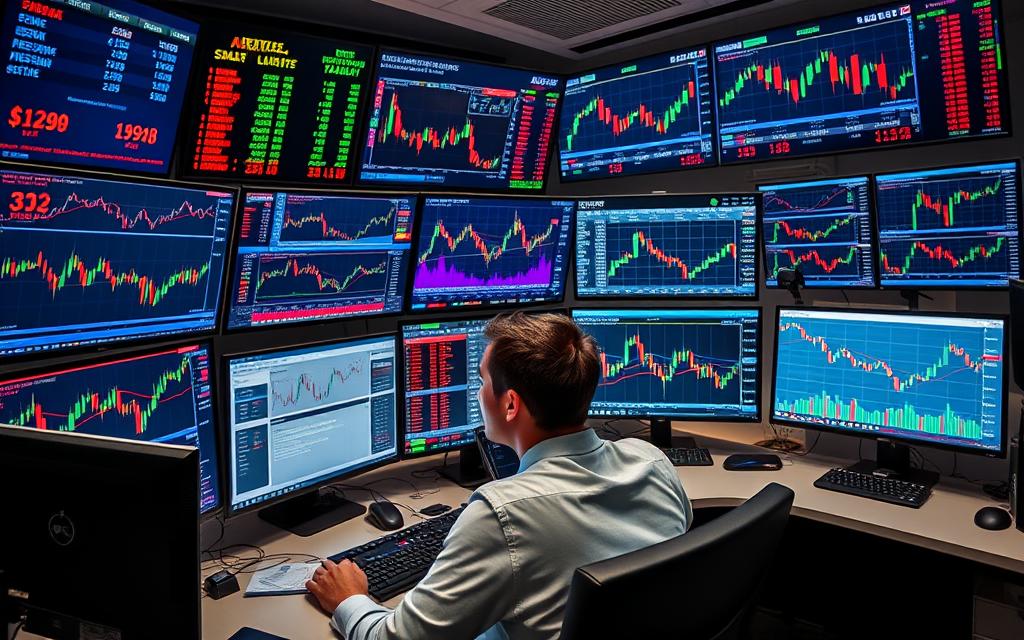
some of the most popular trading strategies for beginners.
1. Buy and Hold Strategy: This strategy involves purchasing a stock or asset and holding onto it for a long period of time, typically years. The idea is to ride out market fluctuations and benefit from long-term growth. This strategy is popular among beginners because it is relatively low-risk and requires minimal active trading.
2. Day Trading: Day trading involves buying and selling stocks or assets within the same trading day. This strategy requires a lot of attention and skill, as traders must closely monitor market trends and make quick decisions. Day trading can be risky for beginners, but some find success with this strategy by starting small and learning as they go.
3. Swing Trading: Swing trading involves buying and holding onto a stock or asset for a short to medium-term period, typically a few days to a few weeks. Traders aim to profit from price swings or “swings” in the market. This strategy is less intense than day trading but still requires careful monitoring of market trends.
4. Trend Following: Trend following is a strategy that involves identifying the direction of a stock or asset’s price trend and trading in the same direction. Traders will buy when the price is rising and sell when the price is falling. This strategy can be effective for beginners who want to follow the market’s momentum and avoid making emotional decisions.
5. Scalping: Scalping is a high-frequency trading strategy that involves making numerous small trades throughout the day to profit from small price movements. This strategy is not recommended for beginners, as it requires advanced technical analysis skills and quick decision-making abilities.
6. Breakout trading: Breakout trading is a strategy that involves entering a trade when the price of an asset breaks above or below a key level of support or resistance. This strategy requires traders to be able to identify strong momentum in the market and take advantage of potential price breakouts. Breakout traders often use candlestick patterns and volume indicators to confirm their trading signals.
Before diving into any trading strategy, it’s important for beginners to educate themselves on the basics of trading, practice with a demo account, and seek guidance from experienced traders. Each strategy has its own risks and rewards, so it’s crucial to choose one that aligns with your risk tolerance and investment goals. With time and practice, beginners can develop their own trading style and find success in the unpredictable world of trading.
Make Your First Steps in Forex Trading
Starting your Forex trading journey is exciting. Choosing the right Forex brokers and platforms is key. Look for reputable brokers like Octa. They offer clear information, competitive prices, and easy-to-use platforms for all traders.
Use online courses, webinars, and Forex analysis tools to learn more. Understanding Forex markets and how to analyze them is important. Also, managing risks well can help you succeed in this fast-paced market.
Forex trading comes with risks, so managing them is crucial. Start with a demo account to get used to trading. As you get more confident, you can trade with real money.
The Forex market is open 24/7, five days a week. This gives you many chances to make money. With the right attitude, discipline, and a love for learning, you can become a successful Forex trader.

What is Forex Trading?
Forex trading, or foreign exchange trading, is the process of buying and selling currencies in the global marketplace to profit from fluctuations in exchange rates. It is the largest and most liquid financial market in the world, with a daily trading volume exceeding $6 trillion.
Here’s an overview of forex trading and how it works:
1. Understanding Forex Trading
What is the Forex Market?
- A decentralized global marketplace where currencies are traded.
- Operates 24 hours a day, 5 days a week, across major financial hubs like London, New York, Tokyo, and Sydney.
Why Trade Forex?
- To hedge against currency risks.
- To speculate on changes in exchange rates for profit.
- For international businesses to facilitate cross-border trade and investments.
2. Key Concepts in Forex Trading
Currency Pairs
- Forex trades involve two currencies, known as a pair (e.g., EUR/USD).
- The first currency is the base currency, and the second is the quote currency.
- Example: In EUR/USD, EUR is the base, and USD is the quote.
Exchange Rate
- The price of one currency in terms of another.
- Example: If EUR/USD = 1.20, it means 1 Euro is worth 1.20 US Dollars.
Bid and Ask Price
- Bid Price: The price a trader can sell a currency.
- Ask Price: The price a trader can buy a currency.
- The difference between the two is the spread, a key cost in forex trading.
Leverage
- A tool that allows traders to control larger positions with a smaller amount of capital.
- Example: With 100:1 leverage, $1,000 can control $100,000.
- Caution: Leverage amplifies both profits and losses.
Pips
- A pip (percentage in point) is the smallest price movement in a currency pair, typically the fourth decimal place (e.g., 0.0001).
Lots
- Currencies are traded in specific amounts called lots:
- Standard Lot: 100,000 units.
- Mini Lot: 10,000 units.
- Micro Lot: 1,000 units.
3. How Forex Trading Works
Mechanics of a Forex Trade
- Speculation: Traders speculate whether a currency will rise or fall in value relative to another.
- Execution: Place a buy or sell order for a currency pair through a forex broker.
- Profit/Loss: The difference between the entry and exit price determines the profit or loss.
Example Trade:
- You believe the Euro will strengthen against the US Dollar.
- You buy EUR/USD at 1.2000.
- Later, the price rises to 1.2100, and you sell.
- Profit: 1.2100 – 1.2000 = 0.0100 (or 100 pips).
4. Types of Forex Markets
Spot Market
- Immediate currency exchange at current market rates.
- Most forex trading occurs here.
Forward Market
- Agreement to buy/sell currency at a future date at a predetermined price.
Futures Market
- Similar to the forward market but traded on regulated exchanges.
5. Participants in the Forex Market
- Retail Traders: Individuals speculating on currency movements.
- Institutions: Banks, hedge funds, and corporations.
- Governments and Central Banks: Influence currency value through monetary policies and interventions.

6. Tools for Forex Trading
Forex Brokers
- Facilitate trades by providing platforms and access to the forex market.
Trading Platforms
- Examples: MetaTrader 4 (MT4), MetaTrader 5 (MT5), cTrader.
- Offer tools for technical analysis, charting, and placing orders.
Charts and Indicators
- Common indicators: Moving averages, RSI (Relative Strength Index), and Fibonacci retracements.
Demo Accounts
- Allow beginners to practice trading with virtual funds before risking real money.
7. Risks in Forex Trading
- Market Volatility: Exchange rates can change rapidly due to economic and geopolitical events.
- Leverage Risks: High leverage can lead to significant losses.
- Lack of Regulation: Choose reputable, regulated brokers to avoid scams.
- Overtrading: Making excessive trades without a clear strategy can drain your capital.
8. Strategies for Successful Forex Trading
Fundamental Analysis
- Focuses on economic indicators like GDP, interest rates, and employment data.
- Example: A strong US jobs report might boost the USD.
Technical Analysis
- Uses charts and historical price data to identify trends and patterns.
- Example: A trader might buy if the EUR/USD breaks above a key resistance level.
Risk Management
- Use stop-loss orders to limit losses.
- Never risk more than 1–2% of your capital on a single trade.
Consistency
- Stick to a trading plan and avoid emotional decisions.
9. Advantages of Forex Trading
- Liquidity: High trading volume ensures easy entry and exit.
- Accessibility: Low capital requirement to start.
- Flexibility: Trade anytime due to 24/5 market availability.
- Leverage Opportunities: Amplify returns with a smaller initial investment.
Forex trading offers exciting opportunities for profit, but it requires knowledge, discipline, and risk management. Start small, educate yourself, and practice with demo accounts before committing real capital. With patience and strategy, you can navigate the forex market confidently.
Are you ready to start exploring the world of forex trading?
Key Takeaways
- The forex market operates 24 hours a day, five days a week, with a daily trading volume of over $7.5 trillion.
- Forex trading involves simultaneously buying one currency while selling another in hopes of profiting from changes in their relative values.
- Understanding forex basics is crucial for anyone looking to navigate this complex market.
- Approximately 80% of trading volume is concentrated in major currency pairs, such as EUR/USD, USD/JPY, and GBP/USD.
- The forex market is influenced by key economic indicators, with a 1% change in interest rates potentially impacting currency values significantly.
- Forex trading accounts for more than 90% of the trading volume in the derivatives market.

Source Links
- How To Start Forex Trading: A Guide To Making Money with FX – https://www.investopedia.com/articles/forex/11/why-trade-forex.asp
- Forex Education: What is Forex Trading & How Does it Work – https://business.bofa.com/en-us/content/what-is-forex-trading-and-how-does-it-work.html
- Introduction to Forex – https://www.schwab.com/forex/what-is-forex
- What is Forex Trading? – How Forex Trading Works – FOREX.com US – https://www.forex.com/en-us/forex-trading/what-is-forex-trading/
- The history of forex – https://www.ig.com/en-ch/learn-to-trade/ig-academy/a-beginners-guide-to-forex-trading/the-history-of-forex
- How did Forex start? History of the foreign exchange market – https://www.atfx.com/en/analysis/trading-strategies/history-of-forex
- A short history of Forex: From pits to pixels – https://www.worldfinance.com/markets/a-short-history-of-forex-from-pits-to-pixels
- What is forex and how does it work? – https://www.ig.com/en/forex/what-is-forex-and-how-does-it-work
- Foreign Exchange Market: How It Works, History, and Pros and Cons – https://www.investopedia.com/terms/forex/f/foreign-exchange-markets.asp
- Forex (FX): Definition, How to Trade Currencies, and Examples – https://www.investopedia.com/terms/f/forex.asp
- 9 Forex Trading Principles to Become a Better Trader – https://tiomarkets.com/en/article/forex-trading-principles-to-become-a-better-trader
- Forex (FX): How Trading in the Foreign Exchange Market Works – https://www.investopedia.com/terms/f/foreign-exchange.asp
- Foreign Exchange (Forex) Trading for Beginners – https://www.schwab.com/learn/story/foreign-exchange-forex-trading-beginners
- What Is Forex (FX) Trading & How Does It Work? | SoFi – https://www.sofi.com/learn/content/what-is-forex-trading/
- Major Pairs: Definition in Forex Trading and How to Trade – https://www.investopedia.com/terms/forex/m/majors.asp
- Forex pairs – https://www.cmcmarkets.com/en/trading-guides/forex-currency-pairs
- The 7 major forex pairs you need to know before you start trading – https://www.home.saxo/learn/guides/forex/the-major-forex-pairs
- Forex Analysis: What it Means, How it Works, Example – https://www.investopedia.com/terms/forex/f/forex-analysis-fundamental-technical.asp
- What Is the Best Method of Analysis for Forex Trading? – https://www.investopedia.com/ask/answers/forex/best-method-of-forex-analysis.asp
- What Is Technical Analysis in Trading? – FOREX.com US – https://www.forex.com/en-us/trading-academy/courses/technical-analysis/understanding-technical-analysis/
- Getting Started in Forex – https://www.investopedia.com/trading/getting-started-forex/
- Forex trading for beginners – https://www.cmcmarkets.com/en/learn-forex/forex-trading-for-beginners
- 10 Tips for Forex Trading Beginners – FOREX.com US – https://www.forex.com/en-us/trading-academy/courses/how-to-trade/tips-for-beginners-forex/
- 5 Tips For Selecting A Forex Broker – https://www.investopedia.com/articles/forex/11/how-to-choose-a-forex-broker.asp
- How to choose the best forex broker – https://www.ig.com/en/trading-need-to-knows/how-to-choose-uk-forex-broker
- How to Choose a Forex Broker – Choosing a FX Broker / Axi – https://www.axi.com/int/blog/education/forex/how-to-choose-a-forex-broker
- Understanding Forex Risk Management – https://www.investopedia.com/articles/forex/10/forex-risk-management.asp
- Top risk management strategies in forex trading – https://www.ig.com/en/trading-strategies/top-risk-management-strategies-in-forex-trading-200630
- Forex Trading For Beginners: 3 Profitable Strategies For 2023 – https://dailypriceaction.com/forex-beginners/forex-trading-strategies-for-beginners/
- Forex trading strategies – https://www.cmcmarkets.com/en/learn-forex/forex-trading-strategies
- Best Forex Trading Strategies & Techniques / Axi – https://www.axi.com/int/blog/education/forex/forex-trading-strategies
- Forex Trading for Beginners: A Step-by-Step Guide – https://mubashercapital.com/forex-trading-for-beginners-a-step-by-step-guide-to-getting-started/
- How to start forex trading: A complete guide for beginners – https://www.home.saxo/learn/guides/forex/how-to-start-forex-trading
- Forex Trading for Beginners: Your Guide to Entering the World of Forex – https://www.finsmes.com/2024/11/forex-trading-for-beginners-your-guide-to-entering-the-world-of-forex.html



